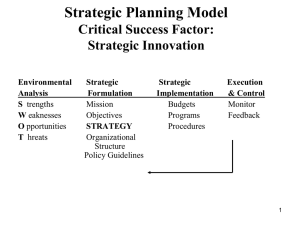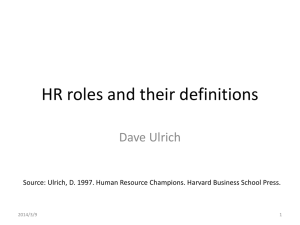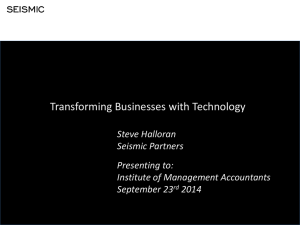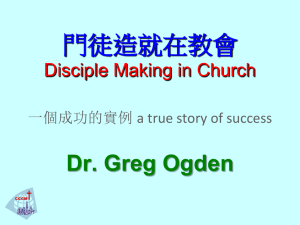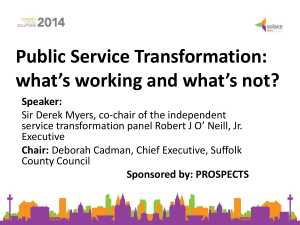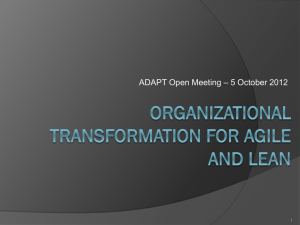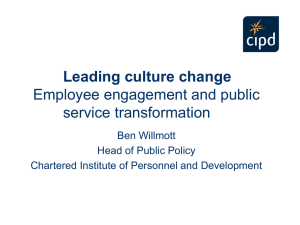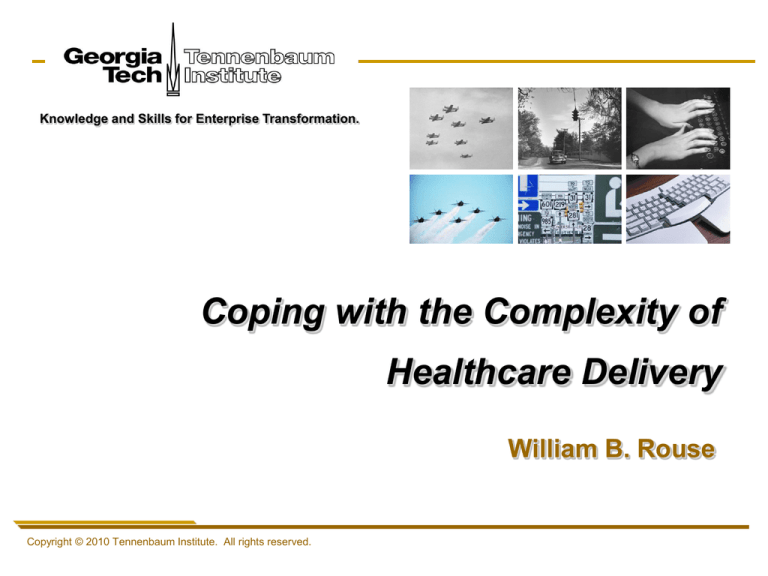
Knowledge and Skills for Enterprise Transformation.
Coping with the Complexity of
Healthcare Delivery
William B. Rouse
Copyright © 2010 Tennenbaum Institute. All rights reserved.
Overview
• System Studies
– Understanding Systemic Consequences of Changes
• Complexity of Healthcare Delivery
– Increasing Complexity Where It Can Best Be Managed
• Health IT Roadmap
– Efficiency, Effectiveness, Evidence Base
• Organizational Simulation
– Driving the Future Before Writing the Check
• Summary
Knowledge and Skills for Enterprise Transformation.
2
System Studies
• Understanding the System
– “Healthcare as a Complex Adaptive System: Implications for
Design and Management”
• Affordability of Healthcare
– “Engineering Perspectives on Healthcare Delivery: Can We
Afford Technological Innovation in Healthcare?”
• Impact of Government Price Controls
– “Impacts Of Healthcare Price Controls: Potential Unintended
Consequences of Firms’ Responses to Price Policies”
• Issues, Information, Incentives & Change
– “Engineering the System of Healthcare Delivery”
Knowledge and Skills for Enterprise Transformation.
3
Complexity
•
•
•
•
•
•
•
•
Complex Adaptive Systems
Stakeholders & Interests
Disease Control
Networks of Networks
Healthcare Network
Complexity Assessment
Implications
Observations
Knowledge and Skills for Enterprise Transformation.
4
Complex Adaptive Systems
•
•
•
•
•
•
They are nonlinear, dynamic and do not inherently reach fixed equilibrium
points. The resulting system behaviors may appear to be random or chaotic.
They are composed of independent agents whose behavior can be described as
based on physical, psychological, or social rules, rather than being completely
dictated by the dynamics of the system.
Agents' needs or desires, reflected in their rules, are not homogeneous and,
therefore, their goals and behaviors are likely to conflict -- these conflicts or
competitions tend to lead agents to adapt to each other's behaviors.
Agents are intelligent, learn as they experiment and gain experience, and
change behaviors accordingly. Thus, overall systems behavior inherently
changes over time.
Adaptation and learning tends to result in self-organizing and patterns of
behavior that emerge rather than being designed into the system. The nature of
such emergent behaviors may range from valuable innovations to unfortunate
accidents.
There is no single point(s) of control – systems behaviors are often
unpredictable and uncontrollable, and no one is "in charge." Consequently, the
behaviors of complex adaptive systems usually can be influenced more than
they can be controlled.
Knowledge and Skills for Enterprise Transformation.
5
Stakeholders & Interests
Stakeholder
Public
Risk Mgt.
Prevention
Detection
e.g., Buy Insurance
e.g., Stop
Smoking
e.g., Get
Screened
Delivery Sys
Government
Physicians
Medicare,
Medicaid,
Congress
Non-Profits
Treatment
Physicians &
Hospitals
NIH, CDC, DoD, et al.
American Cancer Society, American Heart
Association, et al.
Academia
Business Schools
Business
Employers,
Insurance
Companies, HMOs
Knowledge and Skills for Enterprise Transformation.
Basic Science
Disciplines
Technology &
Medical Schools
Medical
Schools
Guidant,
Medtronic, et al.
Lilly, Merck,
Pfizer, et al.
6
Disease Control
Public
Awareness
Public
Readiness
Screening
Available
Costs
Covered
Screening
Effective
Public
Public
Communication Education
Physician
Education
Consumer
Advocacy
Medical
Research
$
$
$
$
$
Public, Delivery System, Government, Non-Profits, Academia, Business
Knowledge and Skills for Enterprise Transformation.
7
Networks of Networks
Accreditation & Licensing
• American Board of Medical Specialties
• Accreditation Council for Graduate Medical Educ.
• Accreditation Council for Continuing Medical Educ.
• AOA Council on Postdoctoral Training
• Federation of State Medical Boards
• Joint Commission on Accreditation of Healthcare Org.
• Liaison Committee on Medical Education
Professional Associations
• American Academy of Family Physicians
Examples of Other Stakeholders
• American Assoc of Retired Persons
• American Medical Association
• American Osteopathic Association (AOA)
• Council of Medical Specialty Societies
• Etc.
• Leapfrog Purchasing Group
• National Business Group on Health
• Etc.
Knowledge and Skills for Enterprise Transformation.
8
Society
Economy
Hospital
Engineering
Organization
Care
Behavior
Physiology
Ubiquitous
Care
Integrative
Medicine
Tissue
Engineering
Genomics &
Proteomics
Biology
Incentive
Reform
Vaccine
Delivery
Drug
Delivery Social Health
Networks
Predictive
Health
Medical
Genetic Risk
Devices
Assessment
Individuals
Knowledge and Skills for Enterprise Transformation.
Economics of
Prevention
Humanitarian
Logistics
Medical
Home
Medicine
Insurance
Reform
Cohorts
Populations
9
Healthcare Network
Government &
Policy Makers
Health
Insurance
Pharmacy
Pharmaceuticals
Health
Wholesalers
Health
Providers
Consumers
Medical
Equipment
R&D Laboratories
Other
Equipment
Knowledge and Skills for Enterprise Transformation.
10
Network Model
4
1
1
1
1
2
2
2
2
3
Nijkl
3
3
Nijk
2
3
Nij
1
3
0
t
Ni
Ni = No. of 1st tier suppliers to ith product/service outlets
Nij = No. of 2nd tier suppliers to ijth Tier 1 supplier, e.g., OEM
Nijk = No. of 3rd tier suppliers to ijkth Tier 2 supplier
Nijkl = No. of 4th tier suppliers to ijklth Tier 3 suppliers
Knowledge and Skills for Enterprise Transformation.
11
Calculating Complexity
T
Ni
m=1
i=1
C = Σ ptm { Σ - p (ni | t) log [p (ni | tm)] +
Nij
Σ - p (nj | ni t) log [p (nj | ni tm)] +
j=1
Nijk
Σ - p (nk | ni nj t) log [p (nk | ni nj tm)] +
k=1
Nijkl
Σ - p (nl | ni nj nk t) log [p (nl | ni nj nk tm)] }
l=1
Knowledge and Skills for Enterprise Transformation.
12
Complexity Assessment
35
Consumer
Great opportunity for
HCI research
Total
30
Complexity (Bits)
25
20
15
10
5
0
Aerospace
Automotive
Knowledge and Skills for Enterprise Transformation.
Retail
Healthcare
Telecom
13
Implications
Traditional System
Complex Adaptive System
Roles
Management
Leadership
Methods
Command & Control
Incentives & Inhibitions
Measurement
Activities
Outcomes
Focus
Efficiency
Agility
Relationships
Contractual
Personal Commitments
Network
Hierarchy
Heterarchy
Design
Organizational Design
Self Organization
Knowledge and Skills for Enterprise Transformation.
14
Observations
• Healthcare is a complex adaptive system and highly
complex, but not as complex as retail markets that
manage complexity to minimize burden on consumers
• Objective should be to increase overall complexity,
where it can best be managed, in order to decrease
complexity for patients and clinicians
• Information management is a key issue, as is creation of
incentives and inhibitions that will motivate stakeholders
to provide quality, affordable care for everyone
Knowledge and Skills for Enterprise Transformation.
15
Health IT Roadmap
•
•
•
•
•
Healthcare Ecosystem
Hierarchical Network
Value-Driven Enterprises
Health IT Roadmap
Health IT Readiness
Knowledge and Skills for Enterprise Transformation.
16
Healthcare Ecosystem
(Society)
Economic Model &
Incentive Structure
Human Productivity &
Healthcare Costs
System Structure
(Organizations)
Competitive Positions &
Economic Investments
Economic Returns &
Performance Information
Delivery Operations
(Processes)
Care Capabilities &
Health Information
Patient Care &
Health Outcomes
Clinical Practices
Knowledge and Skills for Enterprise Transformation.
(People)
17
Hierarchical Network
Healthcare Ecosystem
(Society)
System Structure
(Organizations)
Inter-Level
Information Flow
& Incentives
Delivery Operations
(Processes)
Clinical Practices
(People)
Intra-Level Information Flow & Incentives
Knowledge and Skills for Enterprise Transformation.
18
Value-Driven Nature of Enterprises
Value = Money, Lives, Advantage, Etc.
Delivered Via Value Streams
Enabled by Work Processes
Supported by Information
Enterprise
Efficiency
Evidence
Base
Motivated by Incentives
Revenue
& Profits
Investment
& Returns
Designed Via Analytics
Complex System Models, System Architecture Frameworks, Organizational
Simulations & Games, Network and Ecosystem Visualizations, and Statistical
Knowledge and Skills for Enterprise Transformation.
Methods for Data Mining and Enterprise Intelligence
19
Health IT Roadmap
• Milestone 1: Efficiency
– Value Stream & Work Process Mapping
– Back Office Integration & Automation
– Electronic Medical Records & Health Information Exchanges
• Milestone 2: Effectiveness
– Clinical Decision Support
– Patient & Family Support
– Personalized Medicine
• Milestone 3: Evidence Base
– Operational & Clinical Database Mining
– Every Performance Shortfall & Failure Understood
– Learning System Identify & Deploy Best Practices
Knowledge and Skills for Enterprise Transformation.
20
Healthcare IT Readiness
A Web-Based Assessment Tool
Knowledge and Skills for Enterprise Transformation.
21
Organizational Simulation
• Using IT to Explore Healthcare Futures
– “Driving the Future Before Writing the Check”
• OrgSim Concept
• OrgSim Architecture
• Health Advisor
Knowledge and Skills for Enterprise Transformation.
22
OrgSim Concept
An immersive environment that:
• Simulates future organizations, including
behavioral and social changes
• Enables decision makers to interact within
changed organizational culture
• Synthesizes “people” who behave as if
changes have already happened
• Provides compelling feel for “what it will
be like”
Knowledge and Skills for Enterprise Transformation.
23
OrgSim Architecture
Facilitation, e.g., Training, Advising, Guiding
User Interface, e.g., Large Screens, Voice, Gestures
Organizational Story, e.g., Aging Population
Characters, e.g., Patients, Doctors, Vendors
World Model, e.g., Hospital, City, Economy
Distributed Simulation Software
Hardware, e.g., Computers, Networks
Knowledge and Skills for Enterprise Transformation.
24
Health Advisor
• Motivation
– 10,000 eleven year olds
• Back Story
• The Game
–
–
–
–
Reception Area
Player’s Office
Client Interview
Decision Options
• Research Questions
Knowledge and Skills for Enterprise Transformation.
25
Back Story
Welcome to the Health Advisor business. Your firm helps clients successfully navigate the
healthcare system. People pay you – actually, they pay an annual fee -- for you to help them
make the highest-value decisions regarding their health. You are not a doctor, but you have
much data and information available to help your clients make the best choices. Your goal is
to maximize their health state. Your score is the average health state of your clients divided
by the costs of providing these outcomes.
You also need to stay in business! As you are responsible for all of the costs associated with
your clients’ health, you need to pay careful attention to the performance and costs of the
providers you select for both test and treatments. If you spend more than a client’s annual
fee, the excess costs come out of your account. If you spend less than the fee, the excess
payment goes into your account. Of course, you could save money by providing minimal
treatment, but then your reputation will quickly fade and you would have few if any clients.
Keep in mind that you are providing health advice, but not healthcare. You decide which
doctors and other services to employ. For these providers, your clients are patients. For
you, they are clients who expect value for their annual payment.
Knowledge and Skills for Enterprise Transformation.
26
Knowledge and Skills for Enterprise Transformation.
27
Knowledge and Skills for Enterprise Transformation.
28
Knowledge and Skills for Enterprise Transformation.
29
Knowledge and Skills for Enterprise Transformation.
30
Knowledge and Skills for Enterprise Transformation.
31
MedFile
• Online medical resource
• For each disease
– Symptoms
– Confirming tests
– Treatments
• Description of diseases,
tests, etc.
• Description of medical
specialties
Knowledge and Skills for Enterprise Transformation.
32
Research Questions
• Game Play
– What strategies do players employ to maximize value?
– What strategies do players employ to stay in business?
– How successful are these strategies?
• Information Services
– What information do players access to make decisions?
– How do the type and form of information affect decisions?
– How is value affected by information and decisions?
• Hedging Risks
– How do players hedge the downside risks of client costs?
– What types of insurance do players find attractive?
– How does insurance affect decisions?
•
Education
– What do players learn from Health Advisor?
Knowledge and Skills for Enterprise Transformation.
33
Emory Study
• Study Design
–
–
–
–
–
–
42 Emory undergraduates
Game played over 3 weeks
Survey administered over 1 week
Each player saw 25 clients
Access to EHR and MedFile
Clients across gender, age & conditions
• Game Evaluation Survey
–
–
–
–
–
–
–
Interesting – 4.3
Educational – 4.2
MedFile understandable – 4.2
Provider info. understandable – 3.5
Tests and treatments appropriate – 4.0
Client dialogs make sense – 4.0
Advisor options reasonable – 3.9
Knowledge and Skills for Enterprise Transformation.
• Descriptive Statistics
– Doctor Selection
•
•
Specialists = 63%
PCP = 37%
– Client Evaluation & Test Selection
•
•
•
•
Picked a Body Part 34%
Picked a Specific Condition 42%
Picked a Severity Level 10%
Picked a Specific Test 56%
– EHR View
•
•
Avg./Player = 9.3
Avg./Client = 0.5
– MedFile Access
•
•
Avg./Client = 0.41
Avg./Player = 9.45
– Click Data
•
•
Avg. Click/Client = 30.7
Avg. Clicks/Player = 719.1
– Play Time
•
•
Avg. Time = 1:08hr
Avg. Time /Client = 3:00min
34
Preliminary Results
• Performance – Assessments & Referrals
– Players who spend more time, and clicks, with clients tend to
perform better
– Players who more frequently access MedFile tend to perform
better
• EHR access does not impact performance in our context
and, in fact, has slight negative influence
– This is expected as the information contained in the EHR -- for
the first visit -- does not provide additional knowledge
• Players assessments and referrals improve over time
• Players assessments of a previously seen condition, with
another client, improve significantly
Knowledge and Skills for Enterprise Transformation.
35
Summary
• System Studies
– Understanding Systemic Consequences of Changes
• Complexity of Healthcare Delivery
– Increasing Complexity Where It Can Best Be Managed
• Health IT Roadmap
– Efficiency, Effectiveness, Evidence Base
• Organizational Simulation
– Driving the Future Before Writing the Check
Knowledge and Skills for Enterprise Transformation.
36
Knowledge and Skills for Enterprise Transformation.
37

